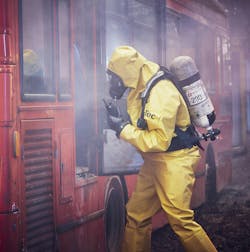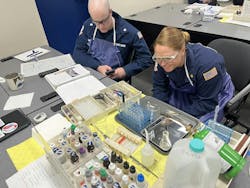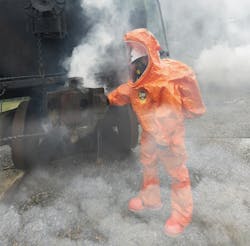How Hazmat Detectors and Suits Make Every Second Count
Key Takeaways
- The newest handheld gas detection devices allow hazmat technicians to identify unknown gases and chemicals in the field more quickly than legacy counterparts.
- Handheld gas detection devices that incorporate wireless connectivity help hazmat teams to make decisions more quickly than the alternative.
- The contribution to enhanced hazmat technician performance by next-generation hazmat suits is impressive, including in regard to time savings.
When the Middlesex County, NJ, Hazardous Materials Unit responded early in 2025 to a report of carbon monoxide alarms going off at an apartment complex, the technicians used their four-gas meter but didn’t pick up any CO. Ordinarily, they might have gone through a series of tube-based tests to confirm the absence of any substance. Instead, one of the technicians suggested that the team break out its 908 Devices XplorIR (pronounced “explorer”) handheld gas detector.
“As soon as my guys went in there, the device sniffed something out,” Bureau Chief Carlos Morales tells Firehouse.
The substance was the flammable gas acetylene. Following the path of the substance’s flow, the team tracked it to leaking acetylene tanks that were in a storage area.
Without the XplorIR, “It would have been a longer ordeal,” Morales says, including the tests themselves but also collecting the components for the testing from various vehicles/storage compartments.
This example of timesavings is indicative of the advantage that’s provided by suppliers across the hazmat response technology spectrum.
No time to waste
What’s noted above doesn’t mean that four-gas meters and other traditional hazmat response equipment doesn’t remain a valuable part of the toolbox. Instead, it means that hazmat tech teams are being afforded innovation that provides the means to improve the efficiency of their work like never before.
“There always has been a gap of ‘What is this gas?’” 908 Devices’ John Johnson explains in regard to the functionality of the XplorIR. “Knowing what a chemical is and how much is present allows teams to compare readings that they get with four-gas meters against things like IDLH thresholds, what PPE requirements might be needed, and additional evacuation protocols that might come into play. Our device transforms that decision-making from sort of an educated guess to being very data-driven, to improve both the speed and safety on any given incident.”
Kent Warrey, who is a hazmat technician with Aberdeen, SD, Fire Rescue, tells of a recent response to a chemical suicide. The victim was in his automobile. Apparently, his suicide attempt with a chemical failed, and he ended up taking his life with a shotgun. Nevertheless, a film coated the inside of the vehicle, and bottles of chemicals were visible through the windows. Initially, the hazmat team ran samples through the department’s chemical threat identification computer.
“People don’t realize that if a sample has more than 10 percent water in it, they aren’t going to be able to find out what the substance truly is,” Warrey explains.
That’s exactly what happened in the case of the attempted chemical suicide. Enter the HazTech Systems HazCat chemical identification system kit.
“One of our technicians who is very good at testing with HazCat went through and picked out the substances,” including ammonia, Warrey tells Firehouse.
Troy Cochran, who is director of operations for HazTech Systems, says the company recently added to its product portfolio its QuickCat RCRA/DOT kit, which bridges the company’s wet-chemistry identification process directly into federal compliance categories. “With this kit, a user can determine where a substance falls under the Environmental Protection Agency/Resource Conservation and Recovery Act hazardous waste categories and Department of Transportation hazard classes, delivering rapid regulatory classification in one streamlined system.”
Engineers with Rigaku applied advanced processing and a 1064 nm laser to the development of the Icon-X, the company’s fourth-generation handheld Raman analyzer, which was introduced in June 2025. Rigaku’s Jen Lynch explains that previous Raman devices required close contact and had limitations with fluorescence interference, mixed substances and challenging packaging. Among the performance upgrades that are delivered, “Technicians get results in seconds with minimal setup,” she says.
Wireless operation
Middlesex County’s Morales points out that the XplorIR’s wireless functionality is a boon to expediency.
“When the device is conducting its analysis, it’ll bounce to my phone, and I can see the information from the command post,” Morales notes.
The same functionality is present in Dräger single-gas monitors for CO and multigas area detection systems. Capable of transmitting live readings through wireless hotspots to centralized experts enables “informed, real-time safety decisions during complex hazmat operations,” Michael Cheek, who is part of the company’s Emergency & Rescue Services, North America, division, says.
Overall protection
Time savings are the result of innovation that’s been applied to the development of hazmat suits, too: for example, Ansell’s AlphaTec Phantom. Having been certified to NFPA 1990: Standard for Protective Ensembles for Hazardous Materials and CBRN Operations in May 2025, the suit is PFAS-free while still delivering fully reusable, fully repairable functionality. That is notable in and of itself.
“The cost of ownership is phenomenal,” Richard Ryan, director, body protection, for Ansell, states.
However, there are numerous elements of the suit’s design that expedites its use. For instance, the optional bayonet glove ring system provides quick and simple glove exchange.
Michael Posadny, who is a battalion chief within the Bureau of Homeland Security/Special Operations of the Toledo Fire and Rescue Department (TFRD), tells Firehouse that members of his team who sampled the suit during its development while they participated in their regular refresher course liked the bayonet system, particularly in instances in which different size suits were in play and in conjunction with the variety of members’ hand sizes.
“Our hazmat technicians really love that there’s no more taping,” he says.
Posadny says the Phantom also is a timesaver on the back end in terms of the availability of a rear-entry zipper. “All that our members have to do is just unzip the back and step out and then go right to decon.”
When the Phantom is released to the market, which will be soon, Posadny says that the TFRD is leaning toward purchasing the suit for the team. “These suits probably will be our 90 percent go-to for hazmat incidents.”
Kappler Growth Strategy Director Brittany Harvey tells Firehouse that her company, which makes the DuraChem 500 CBRN/hazmat protection garment, among others, constantly tests its products’ performance against different chemicals—even those that the company tested in prior years—to support hazmat technicians who might not have the bandwidth to stay up to date on what might have shifted in the field. She points to semiconductor production and what might elude agencies that have these manufacturing facilities in their response district.
“When chemicals are no longer available, whether it be because of the tariffs, trade policy or simply supply, the semiconductor manufacturers substitute with a different chemical,” she explains. “Sometimes, those chemicals don’t react in the same way as the previous ones did and, therefore, can create a different type of hazard scenario that may not have been previously present in the facility.”
The future
Another way that Kappler goes the extra mile for the hazmat technicians: Members of the company’s technical team sit on various NFPA committees. This includes in regard to the NFPA 1990 certification guideline.
“In the proposed new edition NFPA 1990 certification criteria, there are discussions around optional certification to include the OEKO-TEX Restrictive Substances list that could impact products and end users,” Harvey states. “Similar but different to that within PFAS, our technical experts are developing informational articles to help provide more understanding.”
And what fire service topic wouldn’t be complete without consideration of artificial intelligence—in this case, how it will contribute to further hastening hazmat technicians’ performance on scene of incidents.
“We see a future where there’s an AI-driven spectral analysis capability, a cloud-based data-sharing,” 908 Devices’ Johnson says “where that conversion rate just happens, that allows real-time, accurate information, so devices, such as XplorIR, not only identify threats but also move into a state of predicting risk and making recommended mitigation strategies.”
After all, the clock is ticking.
About the Author
Rich Dzierwa
Managing Editor, Firehouse Magazine
Rich Dzierwa joined Firehouse Magazine in 2019 after four tenures with other publications. He was editor-in-chief of Consumers Digest/ConsumersDigest.com and of trade magazine Cutting Tool Engineering. He served as the consumer products reporter for BridgeNews and began his publishing career with an 11-year tenure at Appliance magazine, where he rose to managing editor after serving in other roles. Dzierwa's experience with consumer products, including furnishings, appliances, electronics and space design, has transferred to his Firehouse work regarding the magazine's Station Design columns and the Station Design Awards. Previous work also has contributed to his supervision of several surveys of fire service/EMS members, to produce unique reporting for Firehouse's audience. Dzierwa earned a bachelor's degree in English from Columbia College Chicago.



